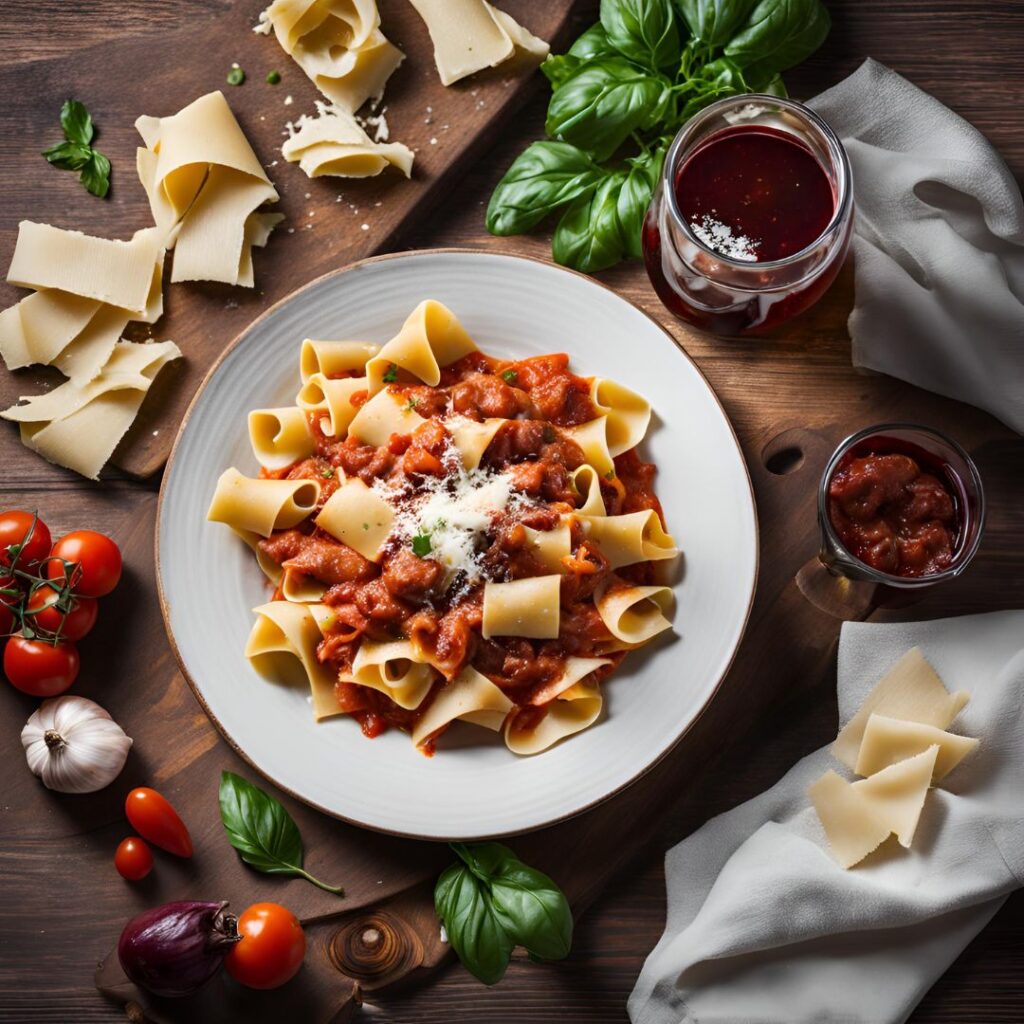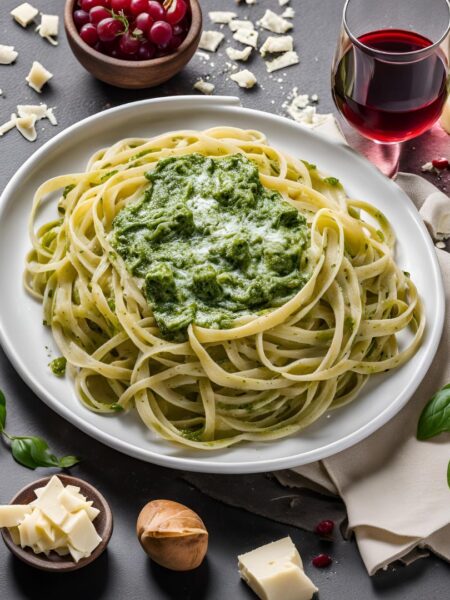Introduction to Marinara Sauce Recipe : A Timeless Italian Classic. Marinara sauce, a staple of Italian cuisine, is more than just a condiment—it’s a symbol of the rich culinary traditions that have shaped the way we enjoy food today. Known for its bold, tangy flavor and versatility, marinara sauce is a beloved accompaniment to an array of dishes, from pasta to pizza to seafood. Its origins trace back to Italy, where fresh, simple ingredients are transformed into something extraordinary through a careful balance of flavors. In this article, we will explore the history, ingredients, and cultural significance of marinara sauce, offering insight into how this vibrant red sauce became a favorite in kitchens around the world.
The Origins of Marinara Sauce
The word “marinara” is derived from the Italian word marinaro, which means “of the sea.” While the name suggests a connection to seafood, the sauce itself has no direct link to fish or shellfish. Instead, it refers to the sauce’s historical use by sailors (marinai) who would prepare simple, easy-to-make meals while at sea. These early marinara sauces were likely made with the most accessible ingredients—tomatoes, garlic, herbs, and olive oil—staples of the Mediterranean diet.
The exact origins of marinara sauce are a subject of some debate, but it is widely believed that it emerged in southern Italy, particularly in Naples, during the 16th century after tomatoes were introduced to Europe from the New World. Before the tomato, Italian cuisine relied on a variety of other sauces, many of which were made with oil, vinegar, and fresh herbs. Once tomatoes became a common ingredient, they quickly became the base for a range of sauces, with marinara being one of the first to gain widespread popularity.
Unlike more complex tomato sauces that incorporate a wide range of ingredients and slow cooking methods, marinara sauce is known for its simplicity and speed. It relies on the natural flavor of tomatoes, enhanced with garlic, basil, oregano, and sometimes a touch of red pepper for heat. The result is a sauce that’s rich in flavor yet light enough to pair with a variety of dishes.
Key Ingredients in Marinara Sauce
The beauty of marinara sauce lies in its simplicity. The core ingredients—tomatoes, olive oil, garlic, herbs, and seasonings—are easily accessible, making it a sauce that anyone can prepare at home. Each ingredient plays a crucial role in creating the signature flavor profile that has made marinara a favorite for generations.
Tomatoes:
At the heart of marinara sauce is the tomato. The type of tomato you use can dramatically affect the flavor of your sauce. In traditional recipes, ripe, in-season tomatoes are preferred, but canned tomatoes—especially high-quality crushed or whole tomatoes—are often used for convenience and consistency. The rich, slightly sweet flavor of tomatoes provides the base for the sauce’s boldness.
Olive Oil:
The Olive oil is the preferred fat for marinara sauce, not only for its healthy properties but also for the depth of flavor it imparts. Olive oil helps to sauté the garlic and onions, releasing their aromas and flavors into the sauce. It also gives the sauce a smooth, rich texture that enhances the overall experience.
Garlic:
Garlic is a quintessential element in Italian cooking, and in marinara sauce, it serves as the aromatic backbone. When sautéed in olive oil, garlic releases its pungent, savory aroma, adding depth and complexity to the sauce. The key is to cook the garlic just enough to release its flavor without allowing it to burn, which can create a bitter taste.
Herbs:
The herbs most commonly used in marinara sauce are basil and oregano, which are both traditional Italian herbs. Basil adds a sweet, slightly peppery flavor, while oregano provides an earthy, slightly spicy note. These herbs complement the natural acidity of the tomatoes and enhance the sauce’s overall flavor profile.
Red Pepper Flakes:
While not an essential ingredient, red pepper flakes are a common addition to marinara sauce, giving it a subtle kick of heat. The amount of spice can be adjusted based on personal preference, making the sauce as mild or as fiery as desired.
Salt and Sugar:
Salt is essential to bring out the flavors of the sauce and balance its acidity, while a small pinch of sugar can help to counteract the tanginess of the tomatoes. The sugar, however, is entirely optional and should only be used if the sauce tastes too acidic.
The Versatility of Marinara Sauce
One of the reasons marinara sauce has remained a beloved classic for so long is its versatility. While its primary use is as a pasta sauce, marinara can enhance a wide variety of dishes, both traditional and contemporary. Its bright, tangy flavor makes it the perfect accompaniment for pasta, but it also shines as a dipping sauce for breadsticks, mozzarella sticks, or fried calamari.
Pasta:
Marinara is, of course, most commonly served with pasta. Whether paired with spaghetti, penne, or rigatoni, marinara sauce serves as a base that complements almost any shape of pasta. The sauce clings to the pasta, creating a satisfying dish that is both hearty and light. For a richer experience, marinara sauce can be combined with meatballs, sausages, or other proteins.
Pizza:
Another classic use of marinara sauce is as a pizza topping. While some pizzas use a white sauce or a pesto base, traditional Neapolitan pizza often features a simple spread of marinara sauce topped with fresh mozzarella, basil, and a drizzle of olive oil. The sauce provides a tangy counterpoint to the richness of the cheese and the crispy crust.
Dips and Appetizers:
Marinara also makes a fantastic dip for appetizers, particularly those that are fried. Whether it’s used as a dip for mozzarella sticks, fried eggplant, or meatballs, marinara adds a zesty contrast to the richness of fried foods.
Seafood:
While marinara is not a “seafood sauce” in the traditional sense, its bright, acidic flavor pairs wonderfully with shellfish and other seafood. A seafood marinara, often made with shrimp, mussels, or clams, combines the sauce with fresh seafood, creating a savory, umami-rich dish that’s perfect served over pasta or with crusty bread.
Meatballs and Sausages:
Another classic Italian pairing is marinara sauce with meatballs or sausages. The savory flavors of the meat, combined with the tangy tomato sauce, create a comforting and satisfying meal.
Marinara Sauce and Its Global Appeal
Though marinara sauce originated in Italy, its simplicity and flavor have allowed it to transcend cultural boundaries and become a global favorite. In the United States, marinara is a mainstay in Italian-American cuisine, often appearing on menus in pizzerias and Italian restaurants. Its popularity in the U.S. led to the development of various adaptations, such as “spaghetti marinara,” which often includes a mix of seafood or other additions to the sauce.
Around the world, marinara sauce is frequently used in fusion dishes that blend Italian techniques with local ingredients. For example, in Latin American countries, marinara sauce might be combined with peppers, cilantro, and other native spices to create a hybrid dish that pays homage to both Italian and regional flavors.
Conclusion
Marinara sauce, with its simple ingredients and robust flavor, has earned its place as one of the most iconic sauces in the culinary world. Whether you’re serving it over pasta, using it as a dipping sauce, or pairing it with seafood, marinara’s bold, tangy character adds depth to any dish. Its versatility, ease of preparation, and rich history make it a true staple of Italian cuisine and beyond. So the next time you reach for that jar of marinara, take a moment to appreciate the centuries of tradition and flavor that have gone into creating this timeless sauce.
Ingredients: Marinara Sauce Recipe
- 1 can crushed tomatoes (28 oz)
- 2 tbsp olive oil
- 4 cloves garlic, minced
- 1 small onion, finely chopped
- 1 tsp dried oregano
- 1 tsp dried basil
- 1/4 tsp red pepper flakes (optional, for a little heat)
- 1/2 tsp sugar (optional, helps balance acidity)
- Salt and pepper, to taste
- Fresh basil or parsley (optional, for garnish)
How to Make Marinara Sauce- Cooking Instructions
Sauté the onions and garlic:
- Heat the olive oil in a large saucepan over medium heat.
- Add the chopped onion and sauté for 4-5 minutes, or until soft and translucent.
- Add the minced garlic and sauté for another 1-2 minutes until fragrant, being careful not to burn it.
Add the tomatoes:
- Stir in the crushed tomatoes (or fresh tomatoes if you’re using those), breaking them down with a spoon if necessary. If using fresh tomatoes, cook them for a few minutes until they release their juice.
Season the sauce:
- Stir in the oregano, basil, red pepper flakes (if using), sugar (if using), and salt and pepper to taste.
- Bring the sauce to a simmer and let it cook uncovered for 20-25 minutes, stirring occasionally. The sauce will thicken and the flavors will meld.
Taste and adjust:
- Taste the sauce and adjust seasoning if necessary, adding more salt, pepper, or sugar to balance the flavors.
Serve:
- Serve the marinara sauce over pasta, as a dipping sauce for breadsticks, or as a topping for pizza.
Total Time Breakdown:
- Prep time: 10 minutes
- Cook time: 25 minutes
- Total time: 35 minutes
Servings:
- Makes about 4 servings (This is enough sauce for 4 medium-sized portions of pasta or to serve as a dipping sauce for a meal).
5 Essential Cooking Tips for Perfect Marinara Sauce
1. Use High-Quality Tomatoes
- The key to a flavorful marinara sauce starts with the best tomatoes you can find. Fresh, in-season tomatoes will give the sauce a bright, vibrant flavor, but for convenience and consistency, high-quality canned tomatoes are often a better choice. Whole peeled tomatoes (San Marzano tomatoes are highly regarded for their sweetness and low acidity) are an excellent option because they tend to have a richer flavor. You can crush them by hand for a chunkier texture or use a blender or food processor for a smoother sauce.
- If using canned tomatoes, always drain off excess liquid to avoid a watery sauce. You can also simmer the sauce a bit longer to reduce the excess moisture.
2. Don’t Rush the Garlic
- Garlic is one of the signature flavors in marinara sauce, but it can easily turn bitter if cooked too quickly or at too high of a heat. When sautéing garlic in olive oil, be patient and cook it over medium heat. Stir the garlic regularly and watch carefully—once it becomes fragrant (in about 1-2 minutes), it’s time to add the rest of your ingredients. If garlic burns, it can impart a harsh, unpleasant flavor to the sauce.
- If you want a more mellow garlic flavor, try slicing the garlic rather than mincing it. This way, it will infuse the oil gently and you can remove it from the sauce later if desired.
3. Balance the Acidity with Sugar (Optional)
- Tomatoes are naturally acidic, and while that acidity is part of what gives marinara its bright, tangy flavor, it can sometimes make the sauce taste a bit sharp or too sour. A small pinch of sugar can help balance out the acidity, especially if you’re using canned tomatoes. The sweetness of the sugar won’t make the sauce taste sweet, but it will mellow the sharpness and allow the other flavors to shine through.
- Add sugar sparingly—start with just 1/2 teaspoon and taste the sauce before adding more. The goal is to create balance, not to make it sweet.
4. Simmer Slowly and Don’t Overcook
- While marinara sauce doesn’t require a long simmer like some other tomato sauces, giving it a bit of time on the stove can help deepen its flavors. After combining the tomatoes, garlic, and herbs, let the sauce simmer uncovered for at least 20-30 minutes. This allows the flavors to meld together and the sauce to thicken naturally. Don’t rush it by cranking up the heat; a slow simmer ensures the sauce develops a richer flavor without becoming bitter.
- Stir occasionally and check the consistency. If the sauce becomes too thick, you can add a splash of water or vegetable broth to loosen it up.
5. Season to Taste (But Don’t Overdo It)
- Simple ingredients are the hallmark of marinara sauce, and the same goes for seasoning. Salt and pepper are crucial, but be cautious when adding other spices. Fresh basil, oregano, and a pinch of red pepper flakes (if you like a little heat) are the traditional seasonings, but over-seasoning can mask the natural tomato flavor. Start with a small amount of herbs and seasonings, then taste as you go, adjusting until it reaches the flavor balance you’re looking for.
- Always taste the sauce towards the end of cooking, as tomatoes can vary in sweetness and acidity depending on the season and brand. If it’s too acidic, add a pinch of sugar; if it’s too bland, a little extra salt or dried herbs can help.
Some More Interesting Recipes –
- Alfredo Sauce Recipe
- Vodka Sauce Recipe
- Pomodoro Sauce Recipe
- Pesto Sauce Recipe
- Carbonara Sauce Recipe
- Bechamel Sauce Recipe
- Arrabbiata Sauce Recipe
- Truffle Cream Sauce Recipe
- Saffron Risotto Recipe
- Tomato Risotto Recipe
- Parmesan Cheese Risotto Recipe
- Chicken Mushroom Risotto Recipe
- Mushroom Risotto Recipe
Important FAQs for Marinara Sauce Recipe
1. Can I use fresh tomatoes instead of canned tomatoes in this recipe of marinara sauce?
Yes, you can definitely use fresh tomatoes in this Marinara Sauce Recipe ! However, for the best results, choose ripe, in-season tomatoes, like Roma or plum tomatoes, which are meaty and low in water content. You’ll need to peel and chop them before cooking. Keep in mind that fresh tomatoes may not be as rich or sweet as canned tomatoes, especially out of season, so you may need to adjust your seasoning. To peel tomatoes easily, score a small “X” on the bottom and blanch them in boiling water for 30 seconds. Once you place them in ice water, the skin should come off effortlessly.
2. What’s the best type of tomato to use for this recipe of marinara sauce?
The best tomatoes for marinara sauce are San Marzano tomatoes, known for their low acidity and natural sweetness. They’re often considered the gold standard for making Italian sauces. If you can’t find San Marzano tomatoes, other varieties like Roma or plum tomatoes also work well. Look for whole peeled canned tomatoes, as they tend to have better flavor and texture than pre-crushed or pureed tomatoes.
3. How long should I cook marinara sauce with this recipe?
Marinara sauce is meant to be quick and simple. After you’ve sautéed your garlic and onions (if using), let the sauce simmer for 20-30 minutes, uncovered. This allows the flavors to meld and the sauce to thicken. It doesn’t need to simmer for hours like a Bolognese sauce, but giving it time to cook will enhance the depth of flavor. If the sauce seems too thin, let it simmer a bit longer to reduce, or add a spoonful of tomato paste for extra thickness.
4. Can I make marinara sauce ahead of time using this recipe?
Yes, marinara sauce can easily be made ahead of time. In fact, it often tastes even better after sitting for a few hours or overnight, as the flavors have time to develop. Simply store it in an airtight container in the refrigerator for up to 3-4 days. Marinara sauce also freezes well. Let it cool completely, then store it in a freezer-safe container for up to 3 months.
5. Should I add sugar to this marinara sauce recipe?
Adding sugar is optional, but it can help balance the acidity of the tomatoes, especially if you’re using canned tomatoes that are more acidic. Start with a small amount—about 1/2 teaspoon—and taste the sauce before adding more. You don’t want the sauce to taste sweet, but rather well-balanced. If your sauce tastes too acidic, a pinch of sugar will help. Alternatively, you can add a small amount of baking soda (1/4 teaspoon) to neutralize the acidity.
6. Can I use dried herbs instead of fresh in this marinara sauce recipe?
Yes, you can substitute dried herbs for fresh in marinara sauce, but be mindful of the quantity. Dried herbs are more concentrated, so use about 1/3 the amount of dried herbs as you would fresh. For example, if the recipe calls for 1 tablespoon of fresh basil, use about 1 teaspoon of dried basil. Add dried herbs early in the cooking process so they can rehydrate and release their flavors. Fresh herbs, on the other hand, should be added towards the end to preserve their bright flavor.
7. What can I do if my marinara sauce is too watery?
If your marinara sauce turns out too watery, there are a few ways to thicken it. You can let it simmer uncovered for longer to reduce the liquid, or add a tablespoon of tomato paste to help thicken and concentrate the flavor. Another option is to blend part of the sauce to break down the tomatoes further, which will naturally thicken it. Avoid adding too much water when cooking the tomatoes, as this will only increase the sauce’s watery texture.
8. Can I make marinara sauce without onions with this recipe?
Yes, marinara sauce can absolutely be made without onions if you prefer a simpler, more minimalist flavor profile. The sauce will still taste great with just garlic, tomatoes, and herbs. Some people also skip the onions for dietary or personal preference reasons. If you skip the onions, consider using a bit more garlic or adding a small amount of shallots for a touch of sweetness.
9. Can I add meat to this recipe of marinara sauce?
Yes, marinara sauce can be made into a meat sauce (like bolognese) by adding ground beef, sausage, or even meatballs. While a traditional marinara is vegetarian, it pairs wonderfully with all types of meat. Just brown the meat first, then add it to the sauce to simmer and absorb the flavors. For a richer meat sauce, you can add a splash of red wine while simmering the sauce, which enhances the depth of flavor.
10. How can I make marinara sauce spicier with this recipe?
If you like a bit of heat in your marinara sauce, you can add red pepper flakes or fresh chili peppers. Start with a pinch of red pepper flakes and taste as you go. You can always add more, but you can’t take it out once it’s in! For a smoky heat, try adding a small amount of smoked paprika or chipotle powder along with the red pepper flakes.
Marinara Sauce Recipe

Ingredients
How to Make Marinara Sauce- Cooking Instructions
Sauté the onions and garlic:
- • Heat the olive oil in a large saucepan over medium heat.
- • Add the chopped onion and sauté for 4-5 minutes, or until soft and translucent.
- • Add the minced garlic and sauté for another 1-2 minutes until fragrant, being careful not to burn it.
Add the tomatoes:
- • Stir in the crushed tomatoes (or fresh tomatoes if you're using those), breaking them down with a spoon if necessary. If using fresh tomatoes, cook them for a few minutes until they release their juice.
Season the sauce:
- • Stir in the oregano, basil, red pepper flakes (if using), sugar (if using), and salt and pepper to taste.
- • Bring the sauce to a simmer and let it cook uncovered for 20-25 minutes, stirring occasionally. The sauce will thicken and the flavors will meld.
Taste and adjust:
- • Taste the sauce and adjust seasoning if necessary, adding more salt, pepper, or sugar to balance the flavors.
Serve:
- • Serve the marinara sauce over pasta, as a dipping sauce for breadsticks, or as a topping for pizza.





